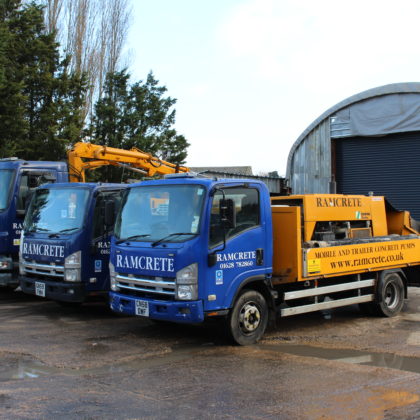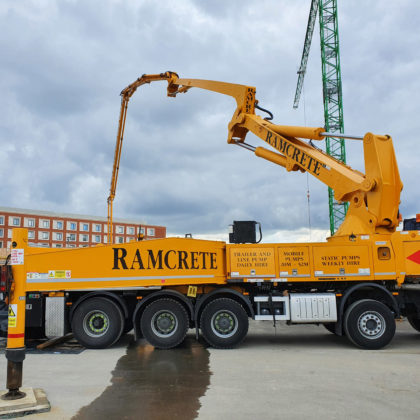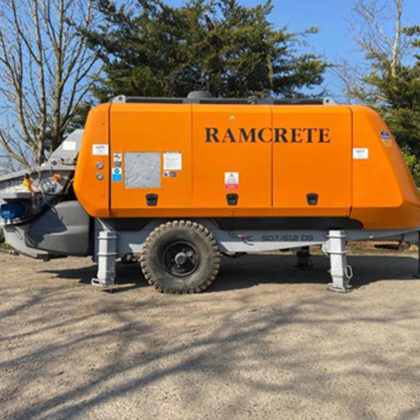Our Guide
1. When would I need a Concrete Pump?
2. What type of Concrete Pump do I need?
3. How far can you pump concrete?
4. What are the advantages of booking Concrete Pumps?
5. What information do I need to give when ordering a pump?
6. What must I supply to ensure a safe and efficient pour?
7. What else do I need to know/consider?
8. How far can you pump concrete?
9. Conditions of supply
When would I need a Concrete Pump?
Over a period of more than half a century, concrete pumps have slowly taken over other traditional methods of transferring liquid concrete. Using a pump is perfect when you have large volumes of concrete or you do not have heaps of time and stacks of manpower to use wheelbarrows on-site.
If the concrete mixer truck cannot reach the area of the pour, or access is restricted/tight/underground/inside etc. then a concrete pump is ideal.
What type of Concrete Pump do I need?
There are 3 main types of concrete pumps: Line, Boom or Static.
Line Pumps
 Line pumps take the concrete from the delivery truck, via a series of pipes laid flat along the ground, to where it is needed. They come with a certified pump operator and for distances over 40m we supply a Linesman to assist install/de-rig the line.
Line pumps take the concrete from the delivery truck, via a series of pipes laid flat along the ground, to where it is needed. They come with a certified pump operator and for distances over 40m we supply a Linesman to assist install/de-rig the line.Boom Pumps
 Boom pumps have a hydraulic arm with the pipeline attached, to reach up and over objects such as walls, houses, obstacles etc to deliver the concrete to harder to reach areas. These come with a certified pump operator.
Boom pumps have a hydraulic arm with the pipeline attached, to reach up and over objects such as walls, houses, obstacles etc to deliver the concrete to harder to reach areas. These come with a certified pump operator.Static Pumps
 Static pumps are similar to Line pumps in their set-up, however but they can pump hundreds of metres away from the pump, making them ideal for tunnelling or high-rise constructions. Static pumps need to be towed or transported onto site and do not come with Operators.
Static pumps are similar to Line pumps in their set-up, however but they can pump hundreds of metres away from the pump, making them ideal for tunnelling or high-rise constructions. Static pumps need to be towed or transported onto site and do not come with Operators.How far can you pump concrete?
Line Pumps can cover distances of circa 90m +, but we can also supply High Pressure Pumps which are designed to pump 150m +.
Our Boom pumps vary in size, starting at 20m and going up to 52m. They also all carry 30m of pipe (steel and flexible pipes) with them allowing for additional horizontal reach.
Static pumps can pump hundreds of metres away.
What are the advantages of booking Concrete Pumps?
- Concrete can be placed exactly where you need it and doesn’t need to be man-handled into place.
- You will require less man-power onsite to distribute the material.
- You’ll save on labour costs.
- Much larger volumes of concrete can be placed per hour. Our Static pumps can shift over 50m3 per hour and reach the tallest high-rise buildings no problem.
- Quicker set-up times. We need approx. an hour on site to set up the pumps and then we’re ready to go.
What information do I need to give when ordering a pump?
- Company name
- Contact name and telephone number for the person booking the pump
- Full site address including postcode
- Date you require the pump (our hires start from 8am but can be booked earlier if needed)
- Type and size of pump required
- Volume, type and strength of concrete including any additions, specialist cement , aggregates fibres etc.
- Any additional requirements for example additional pipeline, extra bends, a Linesman etc.
What must I supply to ensure a safe and efficient pour?
- A safe and level area, with no over-head restrictions, to set-up the pump
- A hard-standing to support the maximum outrigger loadings of the pump
- Polythene or tarpaulin to protect all finished surfaces against splashes or concrete discharge, including under the pump
- Suitable barriers to isolate the pumping operation
- Cement to grout the pipeline – 1 x 25kg bag per 20m of pipeline
- Supplied concrete must be a well homogenised, cohesive pump mix – your ready mixed concrete supplier can advise
- A competent concrete gang to cast the concrete
- A water supply and hose near to the pump to allow the operator to wash the pump at the end of the job.
- Adequate lighting for the full duration of the pumping operation
- A suitable location for the operator to discharge any excess grout – at least 1/3 of cubic metre of concrete will be left in the pump after the pumping operation. If a location is not possible, site must provide a ‘washout box’ of 2m by 2m to fit under the concrete hopper. This should be lined with polythene.
What else do I need to know/consider?
- The pump preparation takes approximately 1 hour to set-up on arrival
- No concrete should be dispatched until the operator has cycled the pump and advised they are ready to pump
- The concrete will be placed into position using the boom where possible. If a ground line is used, the concrete gang will need to move the pipeline as required.
- Concrete is pumped at high pressure. All personnel must be made aware of the risks and dangers associated when pumping concrete under pressure.
- When the truck mixer has discharged its load, the mixer chutes will be cleaned before the mixer leaves. The chutes must not be washed into the hopper as this could cause a blockage and will affect the quality and strength of the concrete.
How far can you pump concrete?
Line Pumps can cover distances of circa 90m +, but we can also supply High Pressure Pumps which are designed to pump 150m +.
Our Boom pumps vary in size, starting at 20m and going up to 52m. They also all carry 30m of pipe (steel and flexible pipes) with them allowing for additional horizontal reach.
Static pumps can pump hundreds of metres away.
- At the end of the pour, the operator will clean all the concrete from the pump and pipeline, and this will take approx. 1 hour. This could be in excess of an hour for longer pipelines or prevalent high air temperatures.
- A daily hire ticket must be signed at the beginning and end of the job.
- For further information please request a site visit and/or consult the “CPA Good Practice Guide – Safe Use of Concrete Pumps”, published by the Construction Plant-hire Association (CPA).
Conditions of supply:
- Ramcrete Pumping Services Ltd supply equipment and plant subject to the CPA Model Conditions for the Hiring of Plant in conjunction with the Supplementary Conditions for Concrete Pumping. These are available on request and are shared upon booking.
- Hires are only accepted under these conditions.
- The hirer must insure against any and all liabilities that might be incurred, including, but not limited to, damage caused when the pump is being operated in confined spaces.

